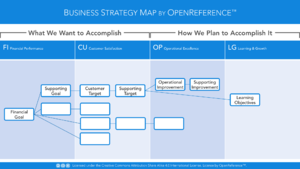Actions
Balanced Scorecard 0 0 Balanced Scorecard,Metrics,Perfomance,Metrics that Matter A tool to manage the internal and/or external performance of a business or supply chain and to monitor the implementation and execution of the business strategy
BSC
Difference between revisions of "BSC"
| Line 5: | Line 5: | ||
* Operational Excellence (OP) | * Operational Excellence (OP) | ||
* Customer Satisfaction (CU) | * Customer Satisfaction (CU) | ||
| − | * Learning and Growth (LG | + | * Learning and Growth (LG) |
| − | These perspectives (called [[ | + | These perspectives (called [[Attribute]]s in {{OR}}) are a first generation view of the {{this}}. Each perspective is measured by one or more [[Metric]]s. For each [[Metric]] the {{this}} has a target value. |
[[File:OR-BSM.png|thumb|Business Strategy Map template]]The second generation adds the Strategy Map concept. The Strategy Map enables the representation of cause and effect between objectives and outcomes. | [[File:OR-BSM.png|thumb|Business Strategy Map template]]The second generation adds the Strategy Map concept. The Strategy Map enables the representation of cause and effect between objectives and outcomes. | ||
Revision as of 15:58, 17 November 2021
The Balanced Scorecard is a Term describing the strategic planning and management Practice to monitor the implementation and execution of the strategy by means of a set of agreed metrics for agreed perspectives.
Balanced refers to implementing diversity in metrics that prevent the risk of implementing a single-perspective strategy. Generally accepted perspectives required in a Balanced Scorecard are:- Financial Performance (FI)
- Operational Excellence (OP)
- Customer Satisfaction (CU)
- Learning and Growth (LG)
These perspectives (called Attributes in OpenReference) are a first generation view of the Balanced Scorecard. Each perspective is measured by one or more Metrics. For each Metric the Balanced Scorecard has a target value.
The second generation adds the Strategy Map concept. The Strategy Map enables the representation of cause and effect between objectives and outcomes.
The third generation adds a Vision Statement, definitions for strategic objectives to the second generation Balanced Scorecard:
- Vision Statement
- Business Strategy Map
- Definitions for Strategic Objectives
- Definitions and targets for Metrics
See also: The Balanced ScorecardDiscuss Contract Custom Solution
Use Cases
Notes
- ↑ R.S. Kaplan & D.P. Norton: The Balanced Scorecard, Harvard Business Review Press
Align Strategy Define Scorecard Discuss Contract Custom Solution
Community Importance Rating:

